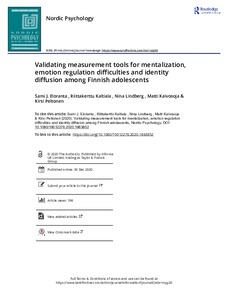Validating measurement tools for mentalization, emotion regulation difficulties and identity diffusion among Finnish adolescents
Eloranta Sami J; Kaltiala Riittakerttu; Lindberg Nina; Kaivosoja Matti; Peltonen Kirsi
Validating measurement tools for mentalization, emotion regulation difficulties and identity diffusion among Finnish adolescents
Eloranta Sami J
Kaltiala Riittakerttu
Lindberg Nina
Kaivosoja Matti
Peltonen Kirsi
ROUTLEDGE JOURNALS, TAYLOR & FRANCIS LTD
Julkaisun pysyvä osoite on:
https://urn.fi/URN:NBN:fi-fe2021042826171
https://urn.fi/URN:NBN:fi-fe2021042826171
Tiivistelmä
Mentalization, emotion regulation, and identity diffusion are theoretically and clinically important transdiagnostic psychological constructs that contribute to mental health. In order to advance meaningful empirical research on these constructs, we need measures that are well tested. In this study, we used confirmatory factor analysis to assess the reliability and construct validity of the Mentalization Questionnaire (MZQ), different versions of the Difficulties in Emotion Regulation Scale (DERS), and the Assessment of Identity Development and Identity Diffusion in Adolescence (AIDA) with data from a general population of Finnish adolescents (N = 360). For MZQ, the factor structure and validity of the subscales were not confirmed. For DERS, a short version, that did not include the lack of emotional awareness subscale was the most coherent and recommendable version of the measure, with a good degree of reliability and a reasonable indication of the convergent and discriminative validity between the subscales. For AIDA, the factor structure was confirmed, but when using this measure for research purposes, it should be taken into account that reverse coding items may affect the factor structure by creating a method factor. The reliability of the AIDA was acceptable, but some of the subscales showed poor convergent and discriminative validity.
Kokoelmat
- Rinnakkaistallenteet [27094]
